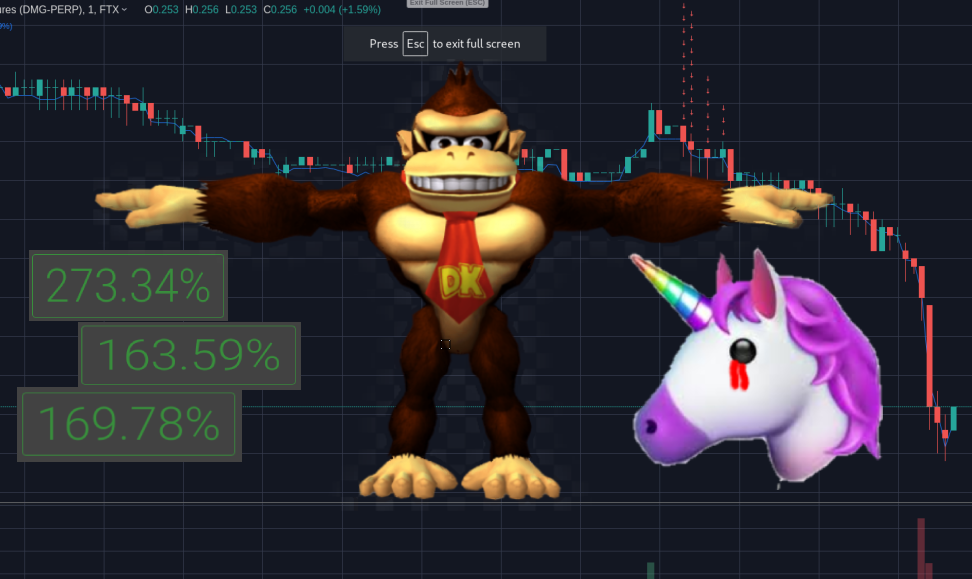
On
the 25th of September the cryptocurrency exchange KuCoin was hacked for
over $200M worth of Bitcoin, Ethereum, and ERC-20 tokens. By gaining
access to the private key of KuCoin's hot wallet, the wallet
used for day-to-day withdrawals and transactions, the hacker was able to
completely drain the funds into addresses they controlled. In this post I
explain how noticing a pattern in the hacker's behaviour and a quick
python script allowed me to earn some sweet satoshis from this unfortunate
event.
The Exchange Heist
Just one day after stealing the funds, the hacker began selling the
>$100m stolen Ethereum ERC-20 tokens, starting with Ocean and Sythetix
Network Token. Selling patterns emerged early on:

Here we see the first instance of selling, the hacker withdraws a portion
of the tokens from the main address (0xeab...) to another address where they then do a test sell of 100 OCEAN on the
Uniswap contract. Once they have confirmed the test sell was successful
they continue to sell the rest of tokens. These test sells happened for a
majority of the tokens the hacker sold and it gave me a few minutes edge
on the market, foreseeing that a sale was about to occur.
Uniswap is a fully decentralised protocol for liquidity provision, i.e.
facilitates trading/switching between Ethereum tokens, in this case the
hacker was selling their tokens for ETH. As Uniswap is truly
decentralised, censoring the hacker's trades is impossible. However,
for some of the more centralised shitcoins, developers manually called
functions within the Ethereum smart contracts in order to recover/freeze
the tokens.
The hacker had huge quantities of tokens, often
controlling 1-3% of a token's entire supply. In an attempt to not
crash token prices by dumping huge quantities on thin orderbooks, the
hacker would sell the stolen tokens in small batches after completing the
test sell. This appeared to be the work of one person, selling semiregular
batches of a token every 1-2 minutes; but sometimes with short breaks.
Later on, you could actually observe the hacker getting less precise
through their typos in transaction amounts, and they became increasingly
distracted as the time gaps between sells grew.
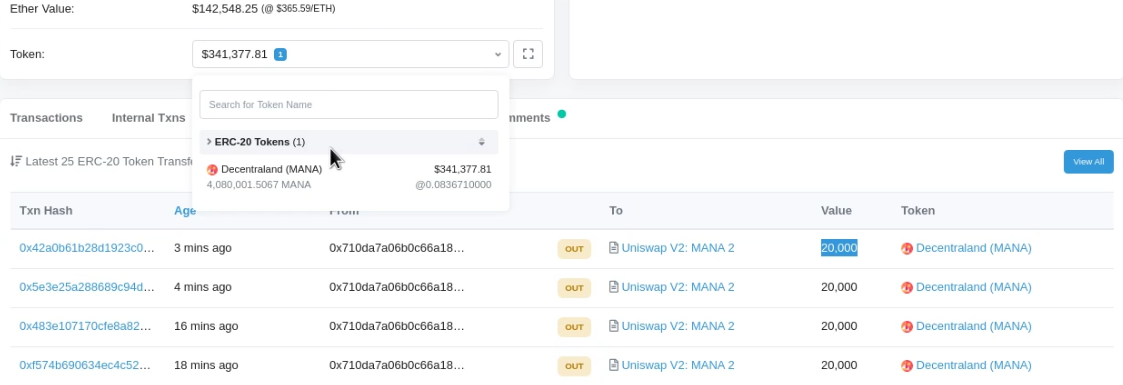
Despite the small batch size of each sell (few thousand USD at a time),
the price of the tokens dumped, and dumped hard. Below we
see a price chart for DIA, where the hacker's batch selling caused a
16% crash.
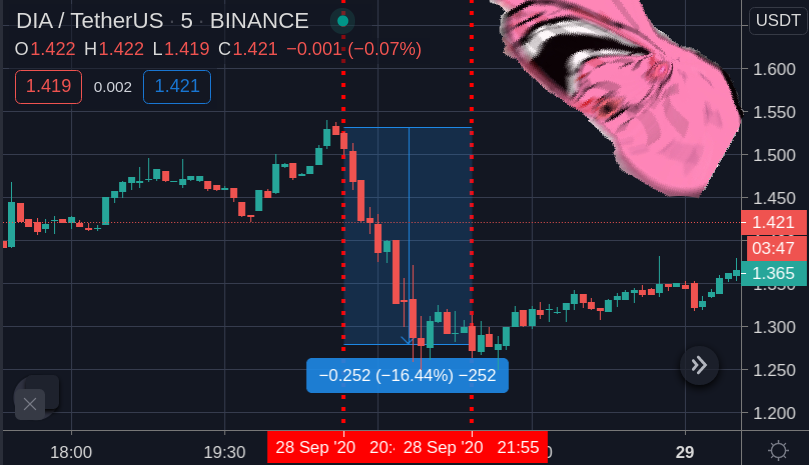
The red lines mark the period for which the hacker was selling DIA,
note how the absence of the hacker selling also marks the exact
bottom!
Like DIA, many of the sold tokens had small market caps (~$10m) with tiny
daily volumes (~$5,000) and the hacker was attempting to sell MILLIONS of
dollars worth quickly. Naturally, the thin orderbooks for these tokens
could not support this immense selling pressure and these tokens were now
on a firesale or deservedly rekt depending on your opinion of their value.
Copy Trading
Quickly noticing the selling and token dumping patterns, I wrote a
basic python script to monitor
the hacker's main token address (0xeab...) for the initial withdrawals to other addresses, from which the selling
on Uniswap would then begin.
<audio controls>
<source src="/assets/images/kucoin/ally.mp3"
type="audio/mpeg">
</audio>
<audio
controls>
<source src="/assets/images/kucoin/gold_please.mp3"
type="audio/mpeg">
</audio>
When I heard the alarm sounds (aoe2 taunt) I would run the script again on
the selling address and listen to the selling begin.
4. Profit!!!!
In order to profit from this price action, I needed a way to short the
tokens. Short-selling, where you borrow an asset to sell now and later
rebuy lower for a profit (hopefully), is only offered on a few exchanges
and with varying limitations. Initially, I attempted to short these tokens
on Binance, but the leverage was often low (lots of margin collateral
required ~30%) and position limits were small. For example, on Binance I
could only borrow 240 DIA, roughly $300 USD, which only returned ~$50 on a
16% crash.
FTX.com on the otherhand, offers
short selling on margin with up to 101x leverage and a position limit of
$25,000 on these small tokens. That means with less than a $250 deposit I
could short $25,000 USD worth of tokens!! Only a handful of the tokens the
hacker had stolen were listed on FTX, but I did manage to catch a couple
of dumps with epic returns
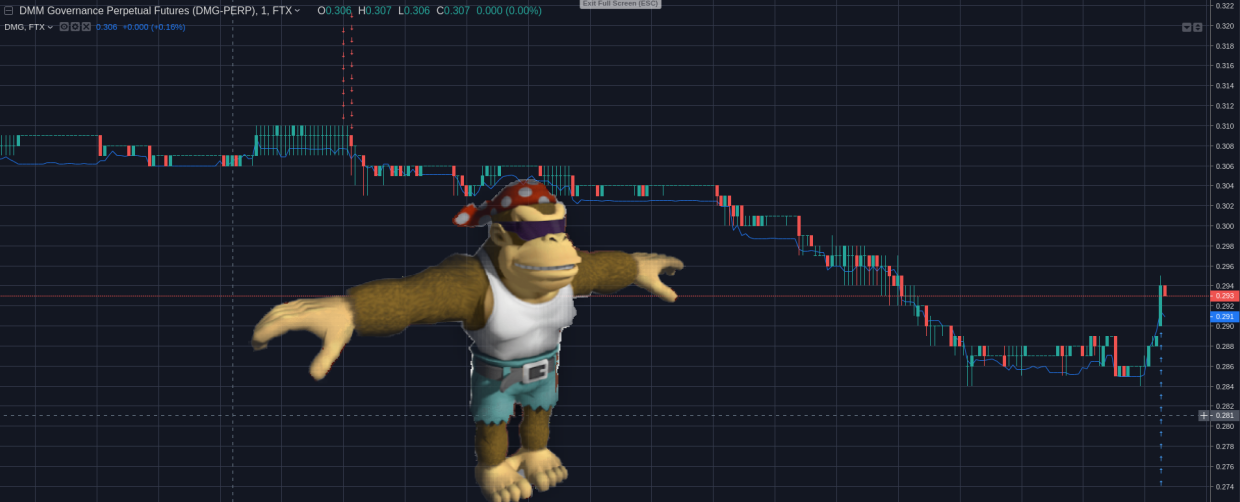
Red arrows == ape in, blue arrows == ape out. Candles are 1 minute.
My strategy became:
- Hear alarm, wake up & run over to laptop.
-
Check the transaction to see what token is being moved. Then, check if
the token trades on FTX.
Make a rough 10-second assessment of downwards potential; DMM had $$\frac{\text{hacker token value}}{\text{daily traded
volume}}\approx\frac{\$1M}{\$2.4M}$$ and a $$\$38M$$ circulating supply
was insane. Other tokens were similar.
-
Place a reduce-only stop-market buy order ~1-2% above the current token
price in order to manage downside risk. The amount should be greater
than the desired position size, and will close my order in the worst
case scenario of a price jump.
-
Market sell roughly 1/3 of my desired position size. If I want to open a
$25k position, I make 3x $8.3k market sells orders.
-
Wait a few seconds before the next order, allowing for algos/bots to
fill up the bid side of the orderbook again so that there is some decent
depth for my next trade to fill into.
-
Market sell again to increase my position size. Repeat, until position
is completely opened. You could spread your entry over more/less than 3
orders, depending on orderbook depth and time preferece. I chose time.
-
Grab a beer and watch my profit/loss climb to hundreds of percent.
-
Watch until the hacker has stops selling, and then market-buy close my
position in a similar way to how I entered.
Sometimes the price would start dumping only a matter of seconds after I
had opened my positions. Thus it was integral that I opened my position as
soon as possible, regardless of small deviations in entry price. For two
weeks I carried my laptop everywhere (not far due to COVID lockdown), even
to the beach at one stage, connected to my mobile hotspot the script would
alert me at any time of day. Me aping in & aping out is why you can
see noticable slippage and a huge spike in volume, I'm the market now.
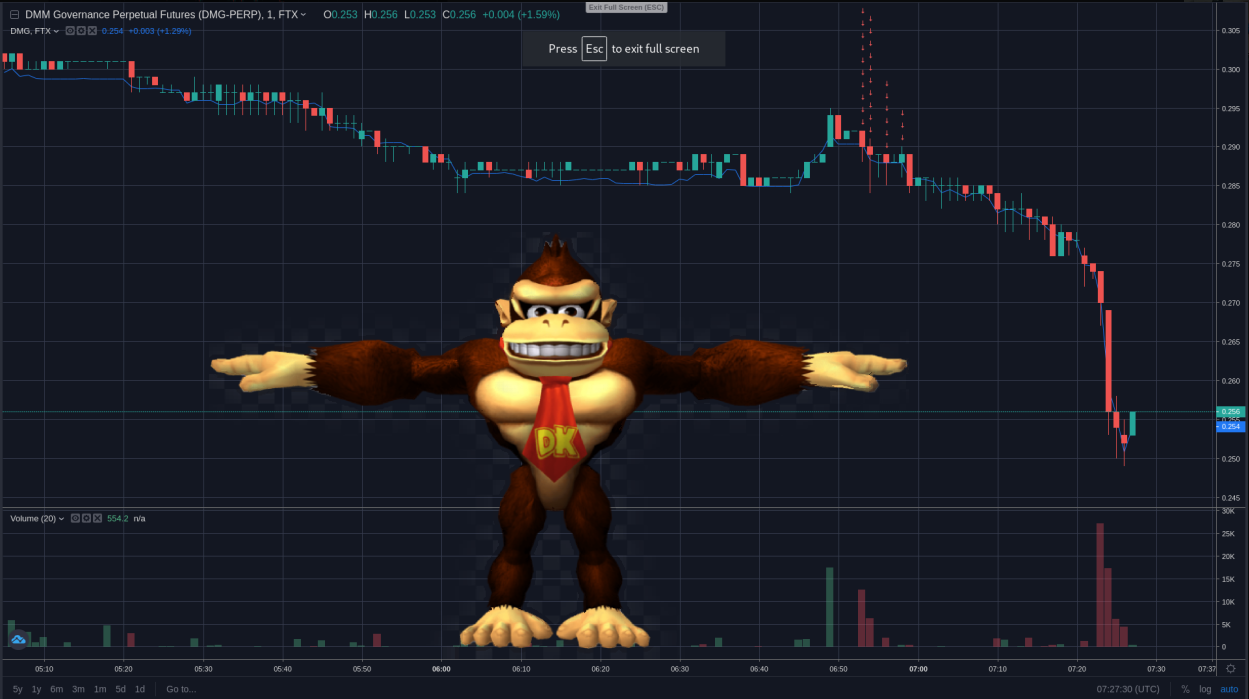
FTX is an awesome exchange with some great derivatives (elections, oil,
gold!).
The hacker seems to have stopped selling for now, but this script and
strategy will likely work in future hacks and in similar scenarios. This
strategy had a 100% success rate and my stop-losses never even came close
to being hit. I speculate that by using Uniswap, the hacker crashed these
coins more than they would have on other exchanges. This is because
Uniswap is an automatic market maker where
slippage is inherent to every trade. When the hacker dumped tokens, arbitrage bots would have bought the
cheaper tokens on uniswap and sold on other exchanges (FTX) in order to
make a profit on the difference, perhaps increasing the severity of of the
crashes given this happened over and over again.
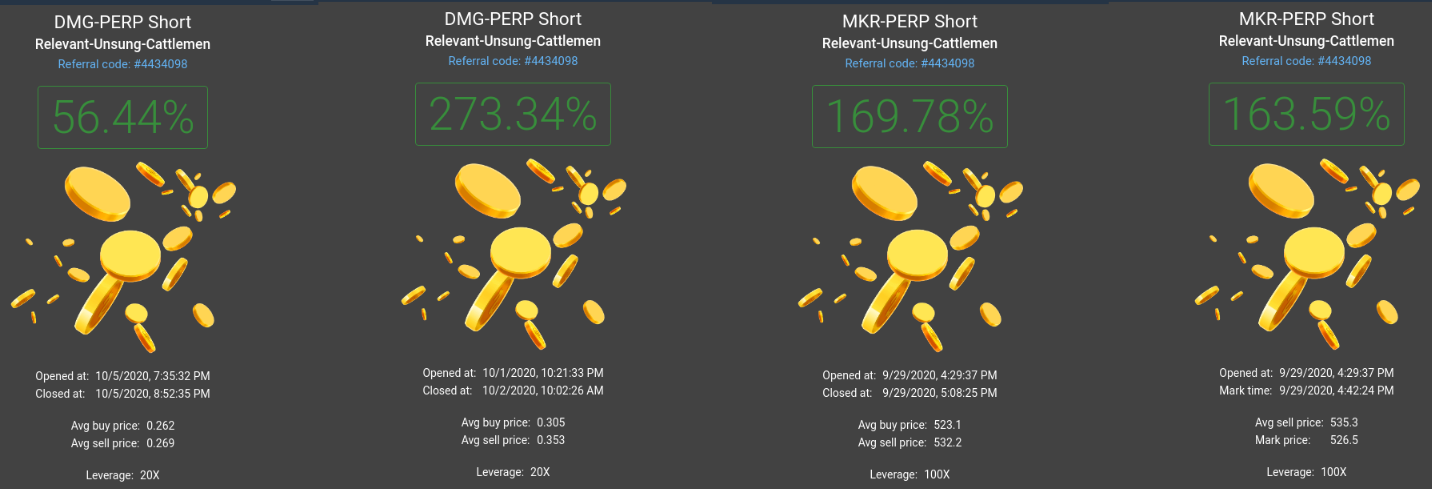
ok
While in some sense this is profiting from the exchange heist, all this
information is openly accessible on the Ethereum blockchain, public
information is fair game. The people on the other side of my trade were
likely either:
- Turkey bots and algos that were not anticipating thanksgiving.
-
Weak hand token 'holders' who panic dumped their investment.
From the tokens I have checked, most recovered from this short wave of
selling. (probably with premine insiders `defending` their coin).
since then
The hackers have been
labelled north korean
since the time of writing this.






